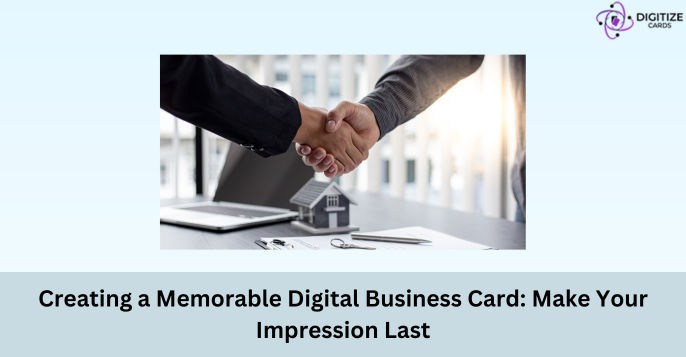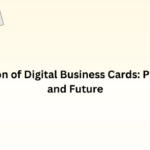In today’s fast-paced digital world, traditional paper business cards are becoming less common. Instead, professionals are increasingly turning to digital business cards to make a lasting impression. A well-designed and thoughtfully crafted digital business card can set you apart from the crowd, help you network more effectively, and ensure that your contact information is easily accessible. In this blog post, we’ll explore how to create a memorable digital business card that leaves a positive and lasting impression on your recipients.
1. Start with a Strong Design
The first step in creating a memorable digital business card is to design it effectively. Here are some design tips to consider:
Keep it Simple: While digital business cards offer more design flexibility than traditional paper cards, it’s essential to keep the design clean and straightforward. Avoid clutter, excessive graphics, and overly complex layouts.
Brand Consistency: Ensure that your digital business card aligns with your personal or company brand. Use colours, fonts, and logos that are consistent with your other marketing materials.
High-Quality Imagery: If you include images or a profile picture, make sure they are of high quality and professional. Blurry or pixelated images can detract from your card’s effectiveness.
Use White Space: White space (or negative space) is essential for readability and aesthetics. Don’t overcrowd your card with text or graphics; give elements room to breathe.
2. Include Essential Information
Your digital business card should contain all the necessary information for recipients to contact you and learn more about you or your business. Here are the key details to include:
Name: Your full name, including any relevant titles or credentials.It is the most critical element of your digital business card. It should be prominent and easy to read. If you hold any professional titles or credentials that are relevant to your industry or field, include them along with your name. For example, if you’re a doctor, you might include “Dr.” before your name. Ensure that the font size and style you choose for your name make it stand out without being overly flashy.
Contact Information: This should include your email address, phone number, and any other preferred methods of contact. Your email address should be professional and easy to remember. Avoid using quirky or unprofessional email addresses; instead, opt for a variation of your name or a company-specific email if applicable.
Also, include your company name, logo, and a brief description of your business or role. Provide a concise and clear description of your role or the nature of your business. This should give recipients a quick understanding of what you do. For example, “Marketing Consultant” or “XYZ Company – Software Development.”
Social Media Links: Provide links to your professional social media profiles, such as LinkedIn, Twitter, or Instagram. Make sure they are up to date and relevant to your professional image.
3. Add Interactivity
One of the advantages of digital business cards is the ability to add interactive elements that engage the recipient. Here are some interactive features to consider:
Clickable Links: Make your email address, phone number, and website clickable so that recipients can easily access them.
Social Media Integration: Include buttons or icons that link directly to your social media profiles. This allows recipients to connect with you on multiple platforms with a single click.
Video Introduction: Consider adding a short video introduction that highlights your personality, expertise, or business offerings. This can be a powerful way to make a personal connection.
QR Code: Include a QR code that, when scanned, leads to your digital business card or website. This is a convenient way for recipients to save your contact information.
4. Choose the Right Format
Digital business cards can be created in various formats, so choose one that suits your needs and preferences:
Mobile Apps: There are numerous mobile apps available that allow you to create and share digital business cards. These apps often come with built-in templates and sharing options.
Email Signatures: Consider incorporating your digital business card into your email signature. This ensures that every email you send serves as a networking opportunity.
PDF or Image Files: Create a PDF or image file of your digital business card and attach it to emails or share it on social media platforms.
Web-Based Cards: Some platforms offer web-based digital business cards that recipients can view in their web browsers. These can be easily updated and shared via a link.
5. Test and Optimise
Before finalising your digital business card, test it on various devices and platforms to ensure it displays correctly and is user-friendly. Check for any broken links, errors, or formatting issues. Optimization is an ongoing process, so regularly update your card to reflect changes in your contact information or branding.
6. Share Your Card Effectively
Once you’ve created your memorable digital business card, it’s essential to share it effectively:
Email Signatures: Add your digital business card to your email signature to ensure that it’s included in all your professional correspondence.
Networking Events: Share your digital business card at networking events, conferences, and trade shows. You can either send it via email or use a QR code for easy sharing.
Social Media: Share your card on your social media profiles to reach a broader audience and make it easy for connections to save your information.
Follow Up: After meeting someone professionally, promptly send them your digital business card as a follow-up, reinforcing your connection.
Conclusion
In 2023, digital business cards offer a myriad of advantages. They provide better accessibility by allowing easy sharing and access through various digital channels, enhancing connectivity within your network. Additionally, digital business cards offer convenience, enabling users to swiftly retrieve information by scanning a QR code or NFC tag, saving valuable time and effort.
Moreover, these digital cards are highly reliable as they eliminate the risk of physical cards getting lost or damaged, ensuring the security of your contact information. Their interactive elements, such as videos and links, facilitate an impressive introduction and effective business showcasing.
By embracing digital business cards, such as those offered by Digitize Cards, you not only streamline your networking but also align with modern trends in professional communication. These cards not only leave a lasting impression but also demonstrate your commitment to innovation and sustainability.
Furthermore, the environmental impact is noteworthy, as digital cards promote sustainability by reducing the need for paper-based cards, aligning with eco-conscious trends. Enterprise digital business cards go a step further, allowing the display of department-specific details, streamlining communication within organizations.
In essence, these benefits are indicative of the prevailing trend of digitizing business interactions in pursuit of efficiency, convenience, and sustainability. Digital business cards elevate accessibility, reliability, and the ability to convey comprehensive information, establishing themselves as invaluable tools for networking and enhancing one’s professional image in 2023.


